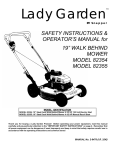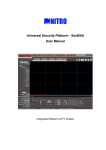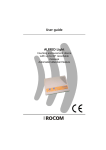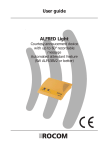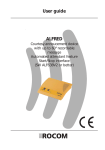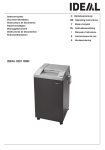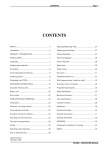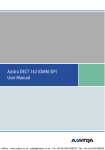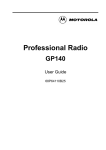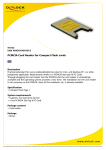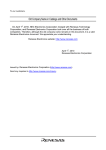Download User guide Doorbus FTZ 100.pmd
Transcript
User guide DOORBUS FTZ USER GUIDE Issue 1.00 DOORBUS FTZ Universal adapter with telephone line interface for the connection of door station with FTZ 123 D12 interface and PA systems to a PBX Page 1 User guide Page 2 DOORBUS FTZ Issue 1.00 User guide DOORBUS FTZ Issue 1.00 Description The universal adapter DOORBUS FTZ allows the connection of door speakers with FTZ 123 D12 interface and PA amplifier to a PBX using a standard analogue telephone extension line. The unit takes palce in a plastic casing which can be installed on a standard DIN bar. The connection to the door speaker is done using the standard interface FTZ 123 D12, typically by connecting the device to the adpater amplifier of the door station manufacturer. The following connections are available: TÖ1/TÖ1' to connect the electrical door opener (max. 40 Vac/2 A), TÖ2/TÖ2' for the optional connection of a second electrical door opener (max. 40 Vac/2 A, an optional relais must be installed inside the device), TS/TS' driver contact to swith the amplifier on/off, NF/NF' 2 wires speech connection to the amplifier. The door speaker and the amplifier must be separatly powered. The volume for microphone and loudspeaker can be adjusted. As for the speech line a galvanic separation is provided more then one DOORBUS FTZ can be connected to the same PBX. For the connection of PA amplifiers the NF/NF' output is connected to a micorphone or AUX input of the amplifier. The sending volume and the impedance can be adjusted using the specifc controller. The TS/TS' driver contact is used to activate the amplifier (i.e. on/off switching). As alternative also the contact TÖ1/TÖ1' can be used. For this second contact a delay for the switch on of the amplifier can be programmed to avoid noises on the loudspeaker of the PA system. With the optional second contact TÖ2/TÖ2' a PA zone selection can be arranged. If the amplifier is drived using the contact TS/TS'(no delay programmable) the TÖ contacts 1 and 2 (optional) can be used to control up to two differente paging zones. For PA systems with speech back function also the microphone direction can be switched on and off. The DOORBUS FTZ itself is completly powered from the telephone line. Please note that the red LED is switched on only during the line seizure. The device is activated using a door chime button. For the button a up to 16 digits long telephone number can be programmed. The chime bell button must have a dry contact. With the PBX the DOORBUS FTZ adapter is connected using two wires to an analogue telephone extension line. If the chime button is activated the lien will be sized, the red LED will go on and the stored telephone number is dialled using DTMF tones. T The telephone number is stored using DTMF dial. The digits 0 to 9, *, # can be part of the telephone number. Using the same procedure also all other programming steps are done. The programming mode activation is protected by a programmable password. Only the selection of the hardware timer duration and the disabling of the automatic answer function are not supported using the DTMF progamming procedure. Those function are selected using jumpers inside the If needed, and when used as an interface to a PA amplifier, the DOORBUS FTZ can Page 3 User guide DOORBUS FTZ Issue 1.00 also be called. With the detection of the first ringing signal the unit will autimatically answer the call and set up the connection. After the call answer the unit will send an acknowledgement tone. For this tone the programmed telephone number is used. If no number has been programmed, no tone will be send. During the connection the user can dial DTMF tones to activate some functions. Dialling the digit 7 will activate the driver contact TÖ1 and the digit 8 the optional driver contact TÖ2. Those are activate for the programmed activation time. If the automatic disconnection after driver contact activation is disabled, the user can repeat this operation more times. Furthermore the microphone of the door speaker can be disabled using the digit 1. The connection is automatocally terminated if the device will detect a busy tone. Also using the DTMF digit 3 the user can disconnect the DOORBUS FTZ adapter manually without opening the door. If the called party doesn't answer within 7 calls the line will be trunkated. For the enhanced security there is also a selectable hardware time. It will ensure that the connection is terminated after a selectable time of 1,2 or 4 minutes whatever status the device has. Features - One dry contact bell chime button can be connected. One 1 to 16 digits (0-9,*,#) long telephone number can be programmed - Programming using DTMF dial tones with password protected access - Programmable door opener activation time (0 to 9 s) - Programmable number of call rings 1 to 99 - Automatic call answer (selectable) - State-of-the-art handsfree speakerphone functionality - Busy tone detection - Volume adjustment for microphone and loudspeaker - Microphone on/off switch using DTMF dial tone - Adjustable impedance for amplifier/door speaker unit - Driver contacts activated by DTMS dial tones (door opener function) - Up to two driver contacts for PA zone selection - Driver contact with programmable on/off delay - Optional second driver contact - Line seizure termination using DTMF dial digit - DTMF dial from outside disabled - Connection to any PBX using a standard analogue telephone line, only two wires - DTMF dial - Hardware call termination timer (selectable) - External line busy indicator (LED) can be connected Page 4 User guide DOORBUS FTZ Issue 1.00 Connection overview - FTZ 123 D12 door station Page 5 User guide DOORBUS FTZ Connection overview - PA system amplifier Page 6 Issue 1.00 User guide DOORBUS FTZ Issue 1.00 Overview - connectors Programmierte Tel.Nr. KT DOORBUS FTZ Universalschnittstelle für Türstationen mit FTZ 123 D12 Schnittstelle DOOR 1/DOOR 2 max. 40 Vdc 2 A TS max. 24 Vdc 0,4 A Bitte beachten! Anzeige und 8 Vdc werden nur bei Belegung eingeschaltet. -+ S/N: LED Loudspeaker volume KT/KT' dry contact input for bell chime button Switch for normal/impedance adjustment mode Microphone volume TS/TS' on/off driver contact for amplifier TÖ2/TÖ2' optional driver contact for door opener/zone 2 TÖ1/TÖ1' driver contact for door opener/zone 1 Overview - internal jumpers J3 1 2 4 J2 3 2 1 J7 -+ 1 2 4 J6 J6 external LED J2 automatic call answer on/off (default on) J7 dc separation for speech line on /off (default off) Socket for optional second relais J3 hardware time 1,2 or 4 minutes (default 2 minutes) Page 7 User guide DOORBUS FTZ Issue 1.00 Installation The DOORBUS FTZ device has been planned for the installation inside a cabinet on a standard DIN bar (9 DIN A modules). Before installing the device please ensure that after taking it out from the package there are no visible damages. With a light shacking please also ensure that none of the internal jumpers has been rempoved during the transportation. If this is the case you can proof the default setting using the overview in the previous page. Please read the following indications! The installation side of the device should be: - in a dry room; - far from dirt, heat an direct sun light; - far from device generating strong electromagnetical fields (like loudspeaker); - far from liquids and chemical agressiv substances. Before you start with the installation please note: - The device can be powered only with voltage indicated on the identification label. - The device doesn't contain maintanable parts and should be opened only by instructed technicians. - If a liquid should get into the device disconnect immediatly the power supply. The device should be opened only by instructed technicians. - To polish the device use only a clean and soft cloth. To remove spots use a umid cloth or a natural cleaning substance. Do not use chemical substances or petrol, these might damage the plastic of the case. - Do not drop or shock the device. - Static discharge may damage the device. Ensure that you discharge yourself using a appropiate grounding before handling the unit. After the installation and cabling, as indicated in the next pages, the devices has to be programmed. For this you need a telephone able to send DTMF dial tones. Further the internal jumper J2 for the automatic call answer must be inserted, as by default. Now you have to call the device using the phone and the telephone number of the extension line where the device has been connected to. The following programmations can be performed: - programmation and change of the telephone number; - number of calls; - automatic line disconnection after driver contact activation on/off; - activation time for driver contact 1 and 2; - manual or automatic microphone activation after call set up; - manual or automatic, time controlled activation of driver contact 1; Page 8 User guide DOORBUS FTZ Issue 1.00 - default data load; - programming or change the password. After programming you can set the functions automatic answer (jumper J2, default on) and the hardware timer (jumper J3, default 2 minutes) as required. To cahnge this settings you have to open the device. Use herefor a small screwdriver and press carefully the closing nipples on the bottom of the device casing to the outside. After change of the jumper setting close the case again. The DOORBUS FTZ is now ready to be used. Set up nw a connection between PBX and door station as described later on. You now have to adjust the speech line impedance. Operate the switch DEV1. A test tone can be heared at the door station and the phone. Please ensure that there is enough distance between phone and door station to avoid larsen effects! Use now the potentiometer PT3 until both LEDs LD3 and LD2 are off or will light alternativly. After this adjust the volumes as required. You can use the controller on the DOORBUS FTZ itself, at the door speaker or on the connected amplifier. Please be sure to regulated carefully. With very noisy external enviroment it can happen that the device is not able to recognize the busy tone. In this case use always the digit 3 to terminate the call manually. Please note that only 1 door opener with 40 Vpp 2 A can be connected to each driver contact. If you need to connect more door opener or you need an higher current, an external relais, i.e. the universla relais 1471E, must be used. Please note the follwing connecting the device to a PBX: - The DOORBUS FTZ adapter is a fixed installation and is not provided with a modular cable connection. - If connecting to a PBX with digital phones, like ISDN terminal equippment, ensure that they are able to send DTMF dial tones, as this is required to open the door and other functions. Page 9 User guide DOORBUS FTZ Issue 1.00 Connection plan - FTZ 123 D12 amplifier TÖ TÖ1 TÖ' TÖ1' KL KT KL' KT' A NF B NF' A to the analogue telephone extension line B Door station, i.e. 1+n wire saving or digital bus system TS TS TS' TS' FTZ 123 D12 amplifier DOORBUS FTZ Connection plan - paging system amplifier Dry contact to drive the selection of the paging zone 1. Driver voltage must be at least 5 V. If a delayed on/off switch of the amplifier is needed then this contact should be used instead of the TS driver contact. Dry contact to drive the selection of the paging zone 2. Driver voltage must be at least 5 V. Audio signal to the amplifier. AUX or microphone input can be used. The output impedance and level can be regulated at the Doorbus device. Also PA system with speech back function can be connected. Z1 TÖ1 Z1 TÖ1' Z2 TÖ2 Z2 TÖ2’ Aux NF Aux NF' A B On/off switch dry contact. The TS contact is activated as soon as the telephone line is seized. A delay can not be programmed for the TS contact! On TS On TS' DOORBUS FTZ Page 10 to the anlogue telephone extension line User guide DOORBUS FTZ Issue 1.00 Activate the programming mode Programming the telephone number 1) Dial using a DTMF phone the extension number where the DOORBUS FTZ is connected to 2) The DOORBUS FTZ will answer the call and send an acknowledge tone (the lenght of the tone depends from the programmed telephone number) 3) Dial now the code * # 0 3) Wait for a acknowledge tone 4) Dial now [programmed password] 5) Wait for a acknowledge tone 6) The programming mode is now activ. 7) Dial the digit 3, to terminate the programming mode 1) Activate the programming mode. 2) Dial now the code * # 1 3) Wait for a acknowledge tone 4) Dial now [telephone number max. 16 digits (1 bis 0, *, #)] ** 5) Wait for a acknowledge tone 6) Dial the digit 3, to terminate the programming mode or 7) You can dial the code for an other progammation Please note: - As default the password "1234" ist set. - If you lose the password there is the possibility to upload the default data using a special procedure. Ask herefore your customer support. - It is also possible to activate the programming mode without a password (see also password programming). In thsi case the programming mode will be activated just after the input of the *#0 code. Please note: - As default ther is no number programmed. - The special digits * and # can be used only for the first digit. - The storing of the ** special dial ist NOT possible. Page 11 User guide DOORBUS FTZ Issue 1.00 Programming the number of calls Programming the automatic call termination 1) Activate the programming mode. 2) Dial now the code * # 2 3) Wait for a acknowledge tone 4) Dial now [the desired number of calls (00 to 99)]. Programming the value 00 the calls will be not counted. The connection is then terminated only using the hardware timer. 5) Wait for a acknowledge tone 6) Dial the digit 3, to terminate the programming mode or 7) You can dial the code for an other progammation 1) Activate the programming mode. 2) Dial now the code * # 3 3) Wait for a acknowledge tone 4) Dial now [1 if the connection must be automatically terminated after the activation of a driver contact] or [0 if the connection should not be automatically terminated after the activation of a driver contact]. 5) Wait for a acknowledge tone 6) Dial the digit 3, to terminate the programming mode or 7) You can dial the code for an other progammation Please note: - As default the value 07 is progammed. - The device will terminate the call when the programmed number of calls is reached and the call was not answered. Page 12 Please note: - As default the value 1 is progammed. - If the automatic call termination is active the line will be trunked as soon as on of the two driver contacts 1 and 2 will be activated at the end of the programmed activation time. - If the driver contact 1 is programmed for automatic activation, the digit "7" will be ignored. With active automatic call termination active after the dial of the digit "8" the driver contact 2 will be activated for the programmed time, after it the driver contact 1 will be opened and after the programmed delay the line will be closed. User guide DOORBUS FTZ Issue 1.00 Programming the manual microphone control Programming the activation time for driver contact 1 and 2 1) Activate the programming mode. 2) Dial now the code * # 5 3) Wait for a acknowledge tone 4) Dial now [0 if the microphon must be switched on with the line seizure] or [1 if the microphone must be switched on manually after call answer.]. 5) Wait for a acknowledge tone 6) Dial the digit 3, to terminate the programming mode or 7) You can dial the code for an other progammation 1) Activate the programming mode. 2) Dial now the code * # 7 3) Wait for a acknowledge tone 4) Dial now [the desired activation time in seconds (1 to 9)]. Programming the value 0 both driver contacts will be disbaled. 5) Wait for a acknowledge tone 6) Dial the digit 3, to terminate the programming mode or 7) You can dial the code for an other progammation Please note: - As default the value 0 is progammed. - With manual activation the microphone will be off at the cal answer. The device can be used only to send speech to the loudspeaker. Dialling the digit "1" the microphone will be activated. Please note: - As default the value 5 is progammed. - The activation time is the same for both contacts (the driver contact 2 is optional). Page 13 User guide DOORBUS FTZ Issue 1.00 Programming the automatic activation of driver contact 1 1) Activate the programming mode. 2) Dial now the code * # 8 3) Wait for a acknowledge tone 4) Dial now [0 if the driver contact 1 is activated manually] or [1 if the driver contact 1 will be activated automatically + the delay time on activation in seconds (0 to 9) + the delay time on deactivation in seconds (0 to 9]. Programming the delay times with 0 will disable the delay. 5) Wait for a acknowledge tone 6) Dial the digit 3, to terminate the programming mode or 7) You can dial the code for an other progammation Please note: - As default the value 0 is progammed. - With manual activation the driver contact 1 (TÖ1) will be activated dialling the digit "7" for the programmed activation time - With automatic activation te driver contact 1(TÖ1) will be automatically activated with the line seizure. If a activation delay is programmed the contact is switched on with this delay in seconds. If a deactivation delay is programmed the contact is switched off and the line will be disconnected after this delay in seconds (i.e. after digit "3", busy tone Page 14 detection, etc.). Example: programming the value *#8155 the driver contact will be activated with 5 s delay after line seizure (i.e. abswering an incomming call). At the detection of a call termination request (i.e. detection of the digit "3" or a busy tone) the device will deactivate at once the driver contact 1 but the line will be closed after a delay of 5 s. User guide DOORBUS FTZ Issue 1.00 Programming the password Programming the default data 1) Activate the programming mode. 2) Dial now the code * # 4 3) Wait for a acknowledge tone 4) Dial now [new password 1 to 4 digits long (only the digits 0 to 9 can be used)] **[repeat the new password 1 to 4 digits long (only the digits 0 to 9 can be used)] ** 5) Wait for a acknowledge tone 6) Dial the digit 3, to terminate the programming mode or 7) You can dial the code for an other progammation 1) Activate the programming mode. 2) Dial now the code * # 999 3) Wait for a acknowledge tone 4) The default data will be loaded 5) Dial the digit 3, to terminate the programming mode or 6) You can dial the code for an other progammation Please note: - As default the value "1234" is progammed. - The special digits * and # can not be used. - Programming the value "0" the password function will be disabled. Please note: - The programmed telephone number will be also deleted. - If you lose the password there is the possibility to upload the default data using a special procedure. Ask herefore your customer support. Page 15 User guide DOORBUS FTZ Issue 1.00 How to use Call from outside - The visitor activates the chime bell button - The telephone line will be seized and the stored number dialled - The extension will be called - At the door station the visitor will hear a ringing tone - If the called party doesn't answer within 7 calls, the call will be terminated - As soon as the called party answers the call he can talk with the visitor - At the end fo the call dial the digit 7 (TÖ1) or 8 (TÖ2, optional) to open the door. The driver contact ist activated for 5 s. or - At the end fo the call dial the digit 3 to terminate the call without opening the door. - Go on hook. Page 16 Call from outside - You want to set up a call with the door station or your PA system. - Go off hook and dial the extension number of the door station or PA amplifier. - The door station or PA amplifier will answer the call automatically. - The audio to your door station or PA system is now active and you can talk to your visitor or make an annoucement. - At the end fo the call dial the digit 7 (TÖ1) or 8 (TÖ2, optional) to open the door. The driver contact ist activated for 5 s. or (in any case with a PA system!) - At the end fo the call dial the digit 3 to terminate the call without opening the door. - Go on hook. User guide DOORBUS FTZ Issue 1.00 Technical data Power supply Standy by voltage on telephoen line Drop voltage at line seizure Consumption Telephone line impedance Dial DTMF dial Tone detection Driver contacts Max. seizure timer Operating temperature EMC Security Dimensions over the telephone line min. 24 Vdc, max. 60 Vdc 10 V +/- 5% at 25 mA Online: min. 0 mA Stand-By: 2 µA 600 Ohm DTMF DTMF standard Make: 70 ms Breake: 70 ms Frequency: 390 to 480 Hz Ringback tone: Make 770 to 1100 ms Call termination after 1to 99 tones (programmable) Busy tone long: Make 170 to 550 ms. Call termination after 5/6 tones Busy tone short: Make 70 to 150 ms. Call termination after 10/11 tones Driver 1: DTMF digit "7" Driver 2: DTMF digit "8" (optional) Min. DTMF tone duration: 45 to 50 ms Max. contact load driver 1 and 2: 40 Vpp, 2 A Activation time: 1 to 9 s programmable 1, 2 or 4 minutes selectable 0° to 45° C EN 60555-2 EN 55022 EN 50082-1 EN 60950 158 x 89 x 57 mm (l x h x d) 9 DIN A modul Page 17 : You hear one of the following tones ACTIVATE PROGRAMMING MODE 3 tones: programming OK, input OK 6 tones: programming error 9 tones: memory error (password, max. 1 to 4 digits) TELEPHONE NUMBER * * Please note! As part of the telephone number also the digits * and # can be used, but only as first digit of the number. (telephone number, max. 16 digits) NEXT PROGRAMMING STEP (number of calls), (calls counting deactivated) NEXT PROGRAMMING STEP AUTOMATIC DISCONNECTION (automatic disconnection disabled), DOORBUS FTZ NUMBER OF CALLS User guide : Dial this digit Brief programming overview Page 18 Call/Answer (automatic disconnection enabled) NEXT PROGRAMMING STEP PASSWORD (password disabled) (new password 1 to 4 digits), (password disabled) Issue 1.00 NEXT PROGRAMMING STEP (new password 1 to 4 digits), User guide MANUAL MICROPHONE SWITCH ON (automatic switch on), (manual switch on) NEXT PROGRAMMING STEP ACTIVATION TIME FOR DRIVER CONTACT 1 AND 2 (time in seconds), (driver contact disabled) NEXT PROGRAMMING STEP (manual activation), (automatic activation) (activation delay in seconds, only with automatic activation!) DOORBUS FTZ AUTOMATC ACTIVATION DRIVER CONTACT 1 (line connection termination delay in seconds, only with automatic activation!)) NEXT PROGRAMMING STEP TERMINATE AND LINE DISCONNECTION Issue 1.00 Page 19 © 2010 ROCOM GmbH. Product may change without notice. We do not respond for any errors or mistake in the present documentation. Printed in Germany. User guide Page 20 DOORBUS FTZ Your dealer: Manufactured by: Energie- und Kommunikationssysteme GmbH Lessing Str. 20, 63110 Rodgau, Deutschland Tel. +49-(0)6106-6600-0 Fax +49-(0)6106-6600-66 E-Mail: [email protected] http://www.rocom-gmbh.com Issue 1.00




















